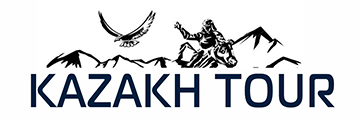.
I have long been captivated by pictures of Kazakhs who use eagles to hunt. In June 2014, my adult son, Jamin, and I had the opportunity to see some of these hunters as part of an 8-day, 7-night trek in Mongolia’s Altai Tavan Bogd National Park with Kazakh Tour (Main Square, Social Services Bldg., 2nd Floor, No. 3, P.O. Box 111, Ulgii, Bayan-Ulgii, Mongolia; phone +976 99422006, www.kazakhtour.com).
We each paid $1,373 for the trek, which included an extra day from the listed itinerary, one night in a hotel in Ulgii (aka Ölgii), a round-trip flight from Ulaanbaatar to Ulgii, meals, snacks and bottled water. (On Kazakh Tour’s website, under “Travel Info,” the recommended list of “what to bring” is right on.)
Reaching our starting point, the town of Ulgii (in Bayan-Ulgii province, which actually borders both China and Russia in far-western Mongolia) was a challenge. First, we had to get to Mongolia’s capital, Ulaanbaatar (aka Ulan Bator) — no small feat. We then would take a 3-hour flight.
Kazakh Tour’s ground operator, Dosjan Khan, whose English is excellent, took care of everything, from initial email contacts and payments to answering our numerous questions. We had complete faith in him and wouldn’t hesitate to travel again with Kazakh Tour.
A few weeks before our June 16 departure from the US, Eznis Airways declared bankruptcy. This left only one airline, Aero Mongolia, with only three planes a week flying between Ulgii and Ulaanbaatar, each carrying 40 passengers. Dosjan was on top of it and got us seats.
Ulgii is halfway around the world, 12 time zones from my home in Kansas. To give you an idea of its remoteness, the Ulgii Airport (ULG) would open shortly before planes arrived and close after their departure.

The airport building did have a color TV (with a Russian station) plus a 2-table café. Beside the small, paved parking lot, the restroom was a 4-door wooden outhouse consisting of four pits, each with two 2×6 boards on which to stand. (Take your own paper.)
From Ulgii, Altai Tavan Bogd National Park’s north entrance was a 10-hour drive away, including lunch and bathroom breaks. We needed a multicountry permit to enter the park, since it was just a few miles from Russia to the north and China to the west. We also had to show our passports at a Mongolian army camp near Lake Khoton.
In contrast to Ulgii’s cold desert climate (less than 5 inches of yearly precipitation), the park had a wide variety of flora and fauna, from rocky, scraggly grass to pine trees, beautiful lakes and streams, and green, flower-covered meadows.
During the next eight days, we did more than 20 hours of driving, always bouncy on dirt roads, along open pastures and muddy tracks. Our caravan of two Toyota Land Cruisers and a Russian jeep often drove through streams, sometimes with the water above the wheels. After a day of this, we stopped holding our breaths each time.
The 5-member Kazakh crew accompanying our 5-person group included two drivers, two cooks and our guide, who is an English teacher at the same school in Ulgii where Dosjan teaches a high school computer class in winter.
They took care of everything: setting up tents, preparing meals, digging a pit toilet at each camp, arranging a day for riding horses, and setting up visits with local nomad families, an eagle hunter and a Tuvan throat singer.
The tents provided by Kazakh Tour were quality alpine type, each with just enough room for a sleeping bag. No open fires were allowed, but a cook tent produced hot food, with plenty of coffee and tea.
University of Kansas hats were welcome gifts to drivers and cooks, but the most favorite gift was a Frisbee. The men played cards, with the winner getting the toy never before seen.
We had originally asked for an extra day so we could climb Malchin Peak, one of five sacred peaks in western Mongolia, but that didn’t happen, as the snow turned out to be deeper than hoped when we arrived on June 21. It was too deep for the camels.

Several months earlier, Dosjan had recommended we wait until mid-July because of the weather, but our work schedules pushed us to take a chance with the earlier slot. Our revised itinerary turned out to be wonderful, though, as we spent two nights camping and hiking in the mountains above Khoton Lake instead of hiking up Malchin.
During our trek, we had the opportunity to interact with seven separate nomad families living in gers(yurts). All were friendly, hardworking and willing to share and interested in their guests.
Each family had animals such as goats, yaks, cattle, horses, sheep and camels. Milking the animals was one of the daily routines. On the tables inside each ger were a variety of milk products, including cheese, dried yogurt, milk fat, butter and suutei tsai, a salty tea with milk.
One rainy day, our vehicles pulled up to a ger and the crew asked if we could take our camp tables and lunch inside. Later I learned that they didn’t even know the family. This was just part of normal nomad culture.
Before we departed Ulgii for the trek, we shopped in a small, modern grocery so we could take sacks of fresh apples and oranges as gifts to the families we visited.
ROD SMITH
Oskaloosa, KS
source: https://www.intltravelnews.com/2015/12/mongolia-kazakh-tour
![]()




My boyfriend and i traveled with kazakh tours, We have booked the Altai Tavan Bogd Mixed tour. The whole tour was just amazing. Thanks for the crew and company, especially to the driver Ada.